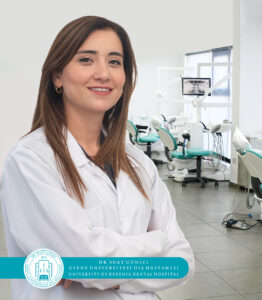Prosthetic Dental Treatment in dentistry refers to the artificial replacement of missing or lost teeth. Dental Implant Applications With the advancement of technology, the use of implants in dental treatments has become more widespread. As a result of all these developments, dental implant treatment has become one of the most commonly used procedures in dentistry in recent years. Dental implants are the most effective and successful method used in the treatment of missing teeth. Titanium screws are placed inside the jawbone, and prosthetic teeth are applied on top of the screws. The difference between implant treatment and other methods is that it does not damage other teeth. As it functions as a tooth root, activities like eating, speaking, laughing, including aesthetics, can be carried out with natural teeth. Smile Design Smile Aesthetics aims to give a natural and aesthetic appearance to a person's smile by evaluating the lips, gums, and teeth appearance individually and then together, in order to bring these factors into the most harmonious form. Smile design is planned to achieve a smile that is personalized, harmonious with the face, and natural. Therefore, the procedures included in smile aesthetics are first shaped according to the patient's needs and then their expectations. Laminate Veneers Laminate veneers, also known as thin porcelain laminate, are thin porcelain plates attached to the front surfaces of teeth. The application of laminate veneers aims to make teeth appear whiter and eliminate dental irregularities, targeting minimum intervention and maximum aesthetics. Laminate veneers give teeth a natural whiteness and are prepared with porcelain plates that are custom-made for the patient's teeth before the procedure. During the procedure, a very thin layer is removed from the tooth surface, and porcelain plates prepared in advance are placed in its place. Due to the use of a special adhesive during the process, it is difficult for the veneers to come off or detach from the tooth surface for any reason. The laminate veneer application ensures that the individual has an aesthetic smile. Laminate veneers are highly resistant to both staining and wear. With proper mouth care, they can be used for many years. New Design for Missing Teeth Prosthetic teeth that are made to replace lost teeth for various reasons are frequently preferred applications today. Missing teeth in the mouth are important both aesthetically and for the overall health of the individual. The purpose of these prosthetic applications is to restore the functions, phonation, aesthetics, and happiness of the patient that have been lost. Dental prostheses can be classified under three headings: fixed prostheses, removable prostheses, and implant-supported prostheses. Fixed Prostheses Fixed prostheses (crown-bridge) are made by using support from existing teeth and are applied by attaching them to the teeth. They cannot be removed by the patient. In the production of fixed prostheses, metal, zirconium-based, or metal-free porcelain materials are used. All-Ceramic Crowns All-ceramic crowns and bridges do not contain a metal inner layer, so they have high light permeability. Thus, natural-looking results similar to natural teeth are obtained, especially in the restoration of front teeth. Full Zirconium - Zirconium Substructure Crowns In porcelain crown and bridge applications, a metal substructure is used for its durability. However, as the negative effects of this metal substructure on the gums, dental tissue, overall body health, and aesthetics are known, an alternative material to metal has been sought over time, and zirconium-supported restorations have been used. Since zirconium is highly durable and has high light permeability, it provides a natural appearance. Removable Prostheses Removable prostheses are a type of prosthesis made by using support from the remaining gum tissue and bones of missing teeth or teeth. Removable prostheses, which the patient can remove whenever they want, are divided into partial and full prostheses. Partial prostheses are connected to the patient's own teeth with precision attachments, so they are more stable than full prostheses. Full prostheses are applied in mouths where all teeth have been extracted. In patients with eroded jawbones, the stability of full prostheses is weak, so when applied with implants, full success is achieved.
Prosthetic Dental Treatment


